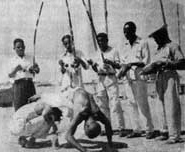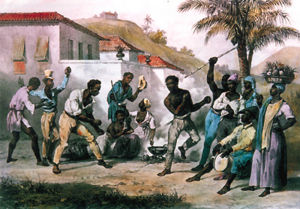History of Capoeira
"Camará, donde é que vens, camará; / camara, donde é que vens, camará?"
Comrade, from whence do you come, comrade; / comrade, from whence do you come, comrade?
capoeira in Brazil
Capoeira is a martial arts form disguised as dance. It originated in Brazil through the slave struggle. The slaves were distributed throughout three major seaports: Rio de Janeiro, Recife, and Bahia. The slaves going through Bahia were mostly from West Africa. The slaves in Rio de Janeiro and Recife, however, were from different regions of Africa, and many were enemies in Africa. Because of this preexisting animosity among all the confusion and hysterical frenzy of fresh enslavement, those slaves in Rio de Janeiro and Recife couldn’t band together and revolt against their Brazilian slave masters.
Palmares, a community of escaped slaves living in the mountains, was instrumental in revolting against the slave masters. The cultural fusion of African tribes led to new fighting techniques that shocked the Brazilians—the first forms of capoeira. With this technique, the Palmares group freed more and more slaves. They left their mountain settlement to trade goods, and while they were away they raided plantations to free the slaves. The diminishing number of slaves drastically changed the economy, which only made the Brazilians more desperate to retrieve their slaves.
"Negroes fighting, Brazil" painting by Augustus Earle
In 1630, the Dutch invaded Brazil. Palmares sided with the Dutch, putting the Brazilians at a huge disadvantage. When Holland won the war, however, the ex-slaves didn’t stop fighting despite many Dutch attempts to stop them. Capoeira developed into a deadly force called “jungle war.”
Regardless of their best efforts, some ex-slaves were recaptured and taken back to the plantations, where they passed on the art of capoeira. As they couldn’t rehearse fighting techniques in front of their masters, they practiced capoeira on Sundays, their only day off. They were forced to practice in the slave quarters, where they wouldn’t be seen. For fear of being caught practicing martial arts, the slaves added music, singing, and dance to the technique so as to disguise it. And so capoeira as we know it spread throughout Brazil.
Capoeira or the Dance of War painting by Johann Moritz Rugendas
After the abolition of slavery in 1888, some slaves returned to Africa. The capoeiristas, those that practiced capoeira, who stayed in Brazil were hired as bodyguards for the politicians. Unfortunately, the government grew to be fearful of the capoeiristas, and it became dangerous to learn capoeira. In the 1890’s, several upper-class citizens began to practice capoeira, and the government viewed capoeira as an immediate threat. To gain control, they wrote a penal code almost entirely dedicated to capoeira and implemented new, harsh consequences for being a capoeirista. Anyone known to practice the art form would be deported. Sampaio, a policeman dedicated to the government of Brazil, knew capoeira and taught it to his police force. He and his men were so deadly with the art that they almost eliminated the practice of capoeira from Brazil. When he arrested an important member of the aristocracy, two members of the cabinet resigned in protest. The aristocrat, however, was deported. This created some unrest in the cities, and a black militia made up of capoeiristas was formed to oppose the president. The police were powerless against the fearful effect the dangerous militia had upon the country.
When Brazil went to war with Paraguay, the lethal capoeirista militia was sent to the forefront of the battle. The former outlaws became heroes.
Today, though capoeiristas are no longer national heroes, they are respected for their deadly abilities. Capoeira, when it was first developed, was practiced as a necessity for survival and learned through rodas. Now it is practiced in schools as an extracurricular activity and is performed to attract more students to the academies (see Capoeira Today).
 capoeira practiced in Brazil
capoeira practiced in Brazil
Home | Dance Styles | Music | Capoeira Today | Bibliography | Perf62 | Basic Terms

